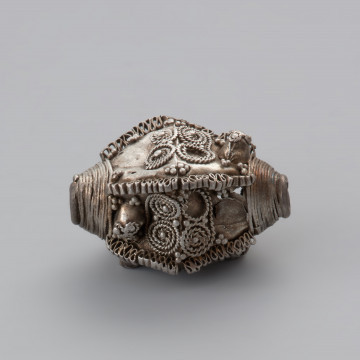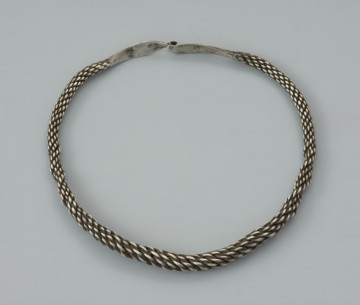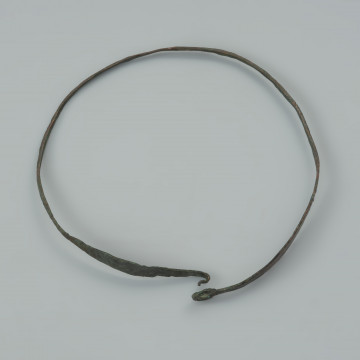
Silver bead
951 — 1000
National Museum in Szczecin
Part of the collection: Middle Ages
The temple ring was discovered in 1887 in a pasture near Mosina, Szczecinek district, in a hoard of silver coins and ornaments found in a clay vessel, which included various European coins and fragments of silver wire. The hoard dates to the period after 1055. The ring is open, with one end cut straight and the other end flattened and into an S-shaped, notched ear. In the case of ornaments of this kind, made of wire, decorations are rare, as decorated pieces were often made out of pieces of metal. Temple rings were some of the most characteristic accessories worn by Slavic women in the early Middle Ages, and they are discovered in graves, within settlements and in hoards. The location of the rings in the burials shows that they were worn on the temples, sometimes more than one, symmetrically or asymmetrically, on both sides of the head or on one side only. They were attached to bands made of leather or fabric, sometimes stiffened with bark. Sometimes, they were also attached to caps or headscarves. They were threaded through small incisions, one after the other, sometimes several rings were threaded through a single incision, often from the largest to the smallest, with the eyelets towards the face.
Ewa Górkiewicz-Bucka
Author / creator
Dimensions
cały obiekt: height: 2.1 cm, width: 1.7 cm, diameter: 1.7 cm
Object type
tempel ring, jewellery
Technique
peening, printing, bending
Material
silver
Creation time / dating
Creation / finding place
Owner
Muzeum Narodowe w Szczecinie
Identification number
Location / status

951 — 1000
National Museum in Szczecin

966 — 1100
National Museum in Szczecin

901 — 1100
National Museum in Szczecin
DISCOVER this TOPIC
National Museum in Lublin
DISCOVER this PATH
Educational path